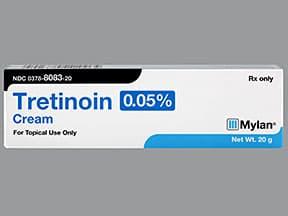In the ever-evolving world of skincare and beauty routines, there’s always a new trend or wonder product promising flawless results. Among the most talked-about are tretinoin, a powerhouse for rejuvenating the skin, and laser hair removal, the golden ticket to silky smoothness. But just like any beauty ritual, they come with their nuances and risks. Welcome to “Smooth Moves: Navigating Tretinoin & Laser Hair Risks,” where we’ll embark on an enlightening journey to uncover the harmony between these two skincare superstars and ensure you navigate their pitfalls like a pro. Whether you’re a seasoned skincare aficionado or a curious newbie, this friendly guide is here to help you achieve that coveted glow without the woes.
Table of Contents
- Understanding Tretinoin: Benefits and Potential Side Effects
- The Science Behind Laser Hair Removal: What You Need to Know
- Tretinoin and Laser Treatments: Key Interactions to Watch
- Pre-Treatment Preparation: Ensuring Your Skin Is Ready
- Post-Treatment Care: Maintaining Smooth and Healthy Skin
- Q&A
- Final Thoughts
Understanding Tretinoin: Benefits and Potential Side Effects
Tretinoin is a powerful tool in the skincare arsenal, widely appreciated for its remarkable benefits. Originally developed to combat acne, this vitamin A derivative has since proven its worth by addressing a range of skin concerns from fine lines and wrinkles to hyperpigmentation. One of its standout features is its ability to accelerate cell turnover, effectively ushering in fresh, glowing skin. This makes it a go-to treatment for those looking to rejuvenate their complexion. Plus, its ability to stimulate collagen production adds an extra layer of skin-firming goodness.
Despite its many benefits, tretinoin is not without its drawbacks. Users often experience a phase called “retinization,” especially in the early stages of use. This period is characterized by redness, peeling, and dryness as the skin adjusts to the potent formula. It’s crucial to start slowly, perhaps applying the treatment every third night, and then gradually increasing the frequency. Other potential side effects include itchiness and a sensation of tightness in the skin. Wearing a moisturizer can help mitigate these effects, making the adjustment process smoother.
To better understand the benefits and side effects, consider this overview:
| Benefits | Side Effects |
|---|---|
| – Reduces fine lines | – Redness |
| – Evens skin tone | – Peeling |
| – Tackles acne | – Dryness |
| – Boosts collagen | – Itchiness |
While navigating tretinoin’s benefits and side effects, don’t forget the basic tips for optimal skin health. Always use a broad-spectrum sunscreen during the day, as tretinoin increases your skin’s sensitivity to UV rays. Pair your routine with a gentle, hydrating cleanser and avoid exfoliants that can exacerbate irritation. Balancing the transformative power of tretinoin with a soothing skincare regimen can make all the difference. So, if smoother, clearer skin is your goal, keep these pointers in mind to maximize the benefits while minimizing the side effects.

The Science Behind Laser Hair Removal: What You Need to Know
Laser hair removal isn’t just about waving a magic wand and making unwanted hair disappear. It’s grounded in fascinating science that uses light and heat to target hair follicles. Specifically, the process revolves around **selective photothermolysis**, a method where the laser precisely destroys hair follicles without damaging the surrounding skin. The pigment in your hair absorbs the light from the laser, which is then converted into heat, effectively zapping the follicle and stalling future growth.
This process relies heavily on the characteristics of both the hair and the skin. The color and thickness of the hair play a significant role in how successful the treatment will be. **Laser wavelengths** are chosen based on these factors to ensure maximum absorption by the hair pigment while leaving the surrounding skin unaffected. Fair-skinned individuals with dark hair often see the best results because the contrast allows the laser to target the follicles more efficiently.
- Ideal Candidates: Fair skin with dark hair.
- Less Effective: Light or grey hair (low pigment).
- Enhanced Results: Multiple sessions required.
| Parameter | Details |
|---|---|
| Wavelength | 700-1400 nm |
| Pulse Duration | Milliseconds |
| Cooling Techniques | Gel, Cryogen Spray |
However, the journey to smooth, hair-free skin isn’t without its hurdles, especially if you’re also incorporating Tretinoin into your skincare regimen. This powerhouse retinoid enhances cell turnover, helping in the treatment of acne and aging. But mixing Tretinoin with laser hair removal requires caution. The high cell turnover caused by Tretinoin can make your skin more sensitive and susceptible to irritation from the laser. It’s generally recommended to pause Tretinoin usage a few days before and after your laser sessions to avoid possible adverse reactions.
Aftercare is crucial to maximize the benefits of laser hair removal. Expect some redness and mild swelling as your skin begins to recover. Applying soothing lotions and using ice packs can help alleviate discomfort. Protecting your skin from the sun is also critical; the newly treated skin is more vulnerable to UV damage. Thus, **wearing sunscreen** and avoiding direct sun exposure for a couple of weeks is a must.
- Stop Tretinoin: A few days before and after sessions.
- Post-Treatment: Cool compresses and soothing lotions.
- Sun Protection: Essential to prevent UV damage.

Tretinoin and Laser Treatments: Key Interactions to Watch
Combining **tretinoin** with **laser treatments** can be a superb approach to achieving smooth, hair-free skin. However, if not done mindfully, it can lead to unwelcome side effects. The key is to be aware of how these two potent beauty allies might interact. Understanding these interactions can help you maintain a clear, vibrant glow without jeopardizing your skin’s health.
Key Points to Remember:
- **Increased Photosensitivity:** Tretinoin increases your skin’s sensitivity to UV rays, which can make laser treatments more intense. Ensure you apply an adequate amount of sunscreen daily.
- **Skin Irritation:** Both tretinoin and laser treatments can cause temporary redness and irritation. To minimize this, try to pause tretinoin application a few days before and after your laser session.
- **Timing Matters:** Ideally, you want to avoid using tretinoin at least 48 hours before and after your laser treatment to prevent any adverse reactions.
Planning your skincare routine around these treatments is crucial.
| **Key Factor** | **Recommendation** |
|---|---|
| **Night Routine** | Avoid tretinoin on nights following laser treatment. |
| **Sun Protection** | Always use SPF 30+ and limit sun exposure. |
| **Hydration** | Use a gentle moisturizer to soothe post-treatment skin. |
Pay attention to your skin’s signals. If you notice persistent redness or swelling, reach out to your dermatologist for advice. Incorporating **gentle skincare ingredients** like aloe vera or hyaluronic acid can also aid in cooling and repairing your skin after treatments. Most importantly, remember that patience is key; spacing out your treatments and adjusting your skincare regimen accordingly will ensure a safe and effective journey to smooth, radiant skin.

Pre-Treatment Preparation: Ensuring Your Skin Is Ready
Embarking on laser hair removal while using tretinoin is an exciting yet delicate dance, requiring careful steps to ensure your skin stays happy and healthy. A little bit of forethought goes a long way here. Firstly, **stop using tretinoin** at least a week before your appointment. This simple but crucial step helps minimize skin sensitivity and potential irritation. Imagine giving your skin a backstage pass to some much-needed downtime before the main event.
- Hydration Station: Keep your skin well-moisturized in the days leading up to your treatment. Dry skin is more prone to irritation and can amplify discomfort during the procedure.
- Sunburn Averse: Avoid sun exposure and tanning beds like the plague. Sunburned skin is a big no-no for laser treatments, and even minimal sun exposure can make your skin more reactive.
- Clean Slate: Make sure to arrive at your appointment with clean, product-free skin. Skip the lotions, perfumes, or makeup on the treatment area for the day.
In the table below, find a brief checklist to keep handy before the big day:
| Task | Timing |
|---|---|
| Stop Tretinoin | 1 week before |
| Moisturize | Daily |
| Avoid Sun Exposure | 2 weeks before |
| Clean Skin | Day of treatment |
Another stellar tip is to **avoid other skin treatments** like chemical peels, waxing, or microdermabrasion at least two weeks before your laser hair removal session. Your skin deserves to be in its most natural state to cope seamlessly with the upcoming laser action. Picture this as a preparatory phase, allowing your skin’s defense team to be at full strength.

Post-Treatment Care: Maintaining Smooth and Healthy Skin
After undergoing treatments with tretinoin or laser hair removal, meticulous care is key to maintaining that enviably smooth skin. **Hydration** takes top priority. Investing in a quality, non-comedogenic moisturizer helps your skin bounce back from potential dryness. Opt for ingredients rich in ceramides and hyaluronic acid. It’s worth your while to apply this hydration hero immediately post-cleansing to trap moisture effectively.
- Avoid harsh exfoliants: Your skin is more sensitive post-treatment, so steer clear of abrasive scrubs and chemical peels for at least a week.
- Stay sun-savvy: Apply broad-spectrum SPF 30 or higher. Treated skin is highly susceptible to UV damage.
- Limit hot showers: High temperatures can further dry out already delicate skin.
Special attention to the **products you use** can make all the difference. Simplify your skincare routine to prevent overwhelming your skin with too many active ingredients. That means temporarily setting aside products like AHAs, BHAs, and retinols. Instead, focus on soothing formulations containing aloe vera, chamomile, or calendula, which offer calming effects without imposing additional stress on the skin.
| Step | Recommendation |
|---|---|
| Moisturize | Twice daily with a hyaluronic acid cream |
| Sunscreen | Every morning, SPF 30+ |
| Gentle Cleanser | Twice a day, non-foaming |
Don’t forget the power of staying **hydrated internally**. Consuming ample water retains the skin’s elasticity and combat dryness from within. Incorporate a diet loaded with antioxidants, such as berries, leafy greens, and nuts, to assist in cellular repair and to ward off free radicals.
Q&A
Q&A: Smooth Moves: Navigating Tretinoin & Laser Hair Risks
Q: What’s the buzz about Tretinoin and laser hair removal? Why should I care?
A: Ah, the duo of skincare and hair-free bliss! Tretinoin, a top-tier retinoid, is a skin savior combating acne and aging, making your skin smoother than a silk sheet. Laser hair removal, on the other hand, zaps away unwanted fuzz, giving you that dolphin-smooth finish. Knowing how these two interact is crucial to keeping your skin safe and enjoying the best of both worlds.
Q: Can I mix and match Tretinoin with my laser hair removal sessions?
A: Mixing Tretinoin and laser hair removal is like hot fudge on ice cream—it can be amazing but needs careful timing. Tretinoin can make your skin more sensitive, increasing the risk of irritation or burns if combined with laser treatment too soon. Typically, dermatologists recommend pausing Tretinoin at least one week before and after your laser session. Always consult with a professional for personalized advice.
Q: What risks are we talking about? Is it really that scary?
A: Don’t worry, it’s not a horror story! The main risks involve skin sensitivity. Using Tretinoin can make your skin more susceptible to burns, hyperpigmentation, or irritation from the laser. It’s like sending your skin to sunbathe after an exfoliation—ouch! Play it safe by adjusting your routine under a dermatologist’s guidance.
Q: Any magic tips for using Tretinoin and getting laser treatments?
A: Absolutely, consider these pointers your magic wand:
-
Timing is Everything: Pause Tretinoin at least one week before and resume one week after your laser session.
-
Hydrate, Baby!: Keep your skin well-moisturized with a calm, hydrating moisturizer to combat any dryness.
-
Sunscreen Saviour: Slather on that broad-spectrum sunscreen like it’s your new best friend. Both treatments can make your skin sensitive to sunlight.
-
Listen to Your Skin: If your skin feels irritated or looks red, give it some extra TLC and consult your dermatologist.
Q: Can I speed up my journey to smooth, glowing skin with both treatments?
A: Patience, dear reader, is a true virtue in skincare. Using Tretinoin and laser hair removal is a bit like cooking a gourmet meal—each step carefully enhances the final experience. Trust the process, follow professional advice, and you’ll soon be basking in the glow and smoothness you’re aiming for, without any hiccups along the way.
Q: So, I’m all set. What’s the final takeaway?
A: You’ve got it! Tretinoin and laser hair removal can work together beautifully with the right approach. Always communicate with your dermatologist, respect the timing, and keep your skin’s needs front and center. Embrace the journey to smoother, healthier-looking skin with confidence!
Remember, skincare is self-care, and navigating the ins and outs of treatments just means you’re a dedicated advocate for your own beautiful skin. Smooth sailing ahead! 🌟
Final Thoughts
And there you have it, dear adventurers in the land of skincare! As you glide seamlessly from the world of Tretinoin to the realm of laser hair removal, remember: knowledge is your best travel companion. A little caution and a lot of care can turn potential pitfalls into mere stepping stones on your journey to radiantly smooth skin.
So, next time you stand before the mirror, armed with your newfound wisdom, give yourself a wink and a nod. You’ve got this. After all, mastering your skincare routine is just another epic quest in the grand adventure of self-care. Here’s to your glowing success and smooth moves! 🌟






